Techniques for the Publication of Accessible Multimedia Content on the Web
Tania Acosta, José Zambrano-Miranda, Sergio Luján-Mora
IEEE Access, 8, p. 55300-55322, 2020. e-ISSN: 2169-3536. https://doi.org/10.1109/ACCESS.2020.2981326
(IEEE'20b)
Revista / Journal
JCR IF (2020): 3.367 - Computer Science, Information Systems: 65/162 (Q2); Engineering, Electrical & Electronic: 94/273 (Q2); Telecommunications: 36/91 (Q2)
Resumen
Multimedia has become one of the most important sources of information and communication on the web. However, despite recent technological progress, people with disabilities and the elderly face difficulties accessing multimedia on the web. In some cases, these difficulties are impossible to overcome and are a fundamental cause of digital exclusion. Given the importance of this topic, several investigations on the problems of accessing multimedia resources have been carried out. Some organizations have also proposed certain standards to guide the creation and publication of accessible web content. Nevertheless, the authoring tools used in the process of publishing multimedia on the web do not offer all the accessibility features required. Authoring tools can also be used by people who do not have knowledge about web accessibility or programming, resulting in web publications lacking accessibility. This research proposes 278 novel techniques to guide authors, designers, programmers, and testers in the publication of accessible and inclusive multimedia on the web. These techniques are designed to guarantee the compliance with the recommended success criteria of Authoring Tools Accessibility Guidelines (ATAG) 2.0 of the World Wide Web Consortium. Moreover, these techniques can be used to evaluate the accessibility of the existing authoring tools used to create multimedia for the web. Additionally, we present 80 possible failures that can cause the non-fulfillment of ATAG 2.0. These failures can help authors discern what to avoid and help evaluators check whether particular multimedia is accessible.
Descarga
Texto completo
I. Introduction
The most recent world report on disability presented by the World Health Organization (WHO) in 2011 revealed that 15% of the world population, approximately 1 billion people, has some type of disability [1]. Of this total, approximately 110 million people experience considerable difficulties in functioning, and 190 million people have a “severe disability” (the equivalent of disability inferred for conditions such as quadriplegia, severe depression, or blindness) [1]. In some countries, the percentage of people with disabilities is higher than that estimated by the WHO. Thus, a study conducted in the United States (U.S.) in 2010 showed that approximately 20% of the total population of the country (309.3 million inhabitants) had some disability, amounting to approximately 57 million people [2]. Similarly, in 2017, the results of a survey conducted in Canada demonstrated that approximately 22% of Canadians over the age of 15 years (approximately 6 million people) had a disability [3]. Likewise, in 2018, a survey on income and living conditions in Europe demonstrated that approximately 25% of the population over the age of 16 faced limitations in their daily activities due to health problems [4]. People with disabilities are considered one of the most vulnerable groups, as they must face multiple barriers or difficulties in performing their daily activities [1].
One of the greatest technological advances in the last 30 years is access to web services, particularly online multimedia content (audio, video, and audio-video) [5]. Multimedia is stored in repositories that contain millions of hours of content in different formats [6]. In this sense, multimedia has become one of the most important sources of information and communication on the web [7]. Statistics show that one-third of all online activities focus on video [7]. This trend will increase according to the report presented by Cisco that stated, “Globally, IP video traffic will be 82 percent of all IP traffic (both business and consumer) by 2022, up from 75 percent in 2017” [8]. Statistics show that on YouTube, approximately 300 hours of video are uploaded per minute and 1,000 million hours of videos are played every day [9]. On Facebook, 8,000 million video views per day are recorded [9].
The availability of multimedia resources in business, public, social, domestic, recreational, and educational areas, among others, is very wide. In the educational field, it is important to consider Article 24 of the Convention on the Rights of Persons with Disabilities, which defends the right to education without discrimination and equal opportunities for people with disabilities [10]. Multimedia is widely used in education, such as e-learning [11]. However, people with disabilities and the elderly face serious problems accessing multimedia published on e-learning platforms [12], and in a general way, they face many barriers to accessing the multimedia published on the web [13]. In some cases, these barriers are created due to the lack of experience of developers in the field of web accessibility. Accordingly, it is suggested that author tools generate accessible web content, regardless of the level of knowledge or information that web designers, developers or authors have.
The publication of multimedia on the web is carried out through web pages that are created by authoring tools such as HTML editors [14]. Several web content editors apply the What You See Is What You Get (WYSIWYG) philosophy, which allows the visualization of the final result when it is created by the author [15]. Additionally, web content editors can be used by people who do not necessarily have knowledge of web technologies such as HTML, JavaScript, CSS, web accessibility, etc. [14].
Therefore, due to recent technological advancements, one might believe that the multimedia published on the web can be seen, perceived and understood by all end-users, from different devices, browsers, networks, platforms and assistive technologies [16]. In contrast, millions of web pages and their multimedia content are not accessible because authors and web developers might have a lack of commitment or experience regarding accessibility, little or no time available to check accessibility problems or a lack of knowledge about the problems faced by people with disabilities and the elderly [13], [17], [18]. These problems have created a technological gap that significantly affects people with disabilities and the elderly, affecting even those who use assistive technologies (screen readers, on-screen keyboards, and so on) [19]. For instance, in the case of videos, the absence of captions, textual transcriptions or sign language causes the exclusion of people with hearing problems [20].
It is important to highlight that the possibility of accessing captions in multimedia resources is also taken advantage of by people without disabilities. In the case of Facebook, one of the most used social networks worldwide, statistics show that approximately 85% of views of their videos are made in silent mode [21]. An investigation conducted in 2016 showed that the use of captions by people who did not have hearing problems was approximately 18%, a figure that could reach 35% depending on the type of content [22]. Likewise, it was determined that 30% of children used captions in the learning categories of services for children by the BBC [22].
Another barrier faced by people with or without disabilities is related to language. For instance, the language of the audio or captions could not be easy to be understood by some users [20]. In addition to the mentioned barriers, limitations in compatibilities of some video players with assistive technology could be considered as another barrier of accessibility to certain sectors of the population [19]. Therefore, web designers and developers need to provide technologies that consider the unique needs of people who must be accounted for and satisfied [23].
To overcome this digital gap and provide an opportunity for all people to access the web, some organizations and institutions have proposed accessibility standards. The Web Accessibility Initiative (WAI) [24], belonging to the World Wide Web Consortium (W3C) [25], has developed a series of guidelines applicable to authoring tools, web content and user agents [26]. Tim Berners-Lee, considered the father of the web, stated that through appropriate hardware and the web, people have gained the possibility to interact like never before [24]. As a result, a new hope of inclusion for people with disabilities emerged with the use of web products and services [26].
This research is based on two articles that we previously published [27], [28]. The first article contains the results of an analysis of the accessibility requirements of video players in e-learning [27], and the second article corresponds to the analysis of the accessibility of educational videos in Massive Open Online Courses (MOOCs) [28]. These investigations allowed us to acquire deeper knowledge about the accessibility requirements that multimedia must fulfill and the difficulties faced by people with disabilities. Additionally, the results obtained in these investigations provided us insight to suggest new primary investigations. To the best of our knowledge, no existing studies propose techniques for publishing accessible multimedia content based on Authoring Tool Accessibility Guidelines (ATAG) 2.0.
Thus, the purpose of this study is to propose a novel set of techniques1 to guide the authors in meeting the success criteria for the publication of multimedia content accessible on the web. Additionally, these techniques will allow anyone to evaluate the accessibility features of the authoring tools used to create multimedia content. The details and structure of the techniques presented in this work will help experienced and inexperienced authors better understand the area of web accessibility. One of the motivations to carry out this research was to substantially contribute to the reduction of the gap that affects millions of people with or without disabilities due to the lack of accessibility of multimedia resources on the web. This inaccessibility could be the result of the lack of techniques that guide compliance with the recommendations given by the current accessibility guidelines of the authoring tools proposed by the WAI.
The rest of this paper is structured as follows. Section II describes multimedia-related concepts, multimedia content in HTML 5, browsers, media players and web accessibility standards. Section III highlights works related to our research. Section IV exposes the methodology and materials used to determine the proposed techniques to meet the success criteria for the publication of multimedia content, consistent with the accessibility guidelines proposed by the WAI, the Universal Design (UD) and other sources. Section V proposes accessibility techniques for publishing multimedia content through authoring tools. Section VI presents a discussion on the contribution of web accessibility standards and some suggestions to improve them. Finally, Section VII presents the conclusions and possible future work that might originate from this research.
II. Background
In this section, the necessary concepts to understand the characteristics of multimedia from the accessibility perspective are presented.
A. Multimedia
Multimedia on the web includes sound, music, videos, movies, and animations [29]. Some accessibility terms related to multimedia include audio descriptions, captions, clean audio, extended audio descriptions, sign language, text video descriptions and transcriptions. To document the terms used in this article, a description of each term is included and taken from the glossary of ISO/IEC 40500:2012 (W3C) [30] and the draft on media accessibility user requirements [31]:
Audio descriptions are descriptions added to the soundtrack that contain essential visual details for understanding. An audio description is added during pauses in the dialogue.
Captions are transcriptions of the dialogue in which speakers are identified. Captions include sound effects and the audio or video information needed to understand their content. Captions that can be activated or deactivated are known as closed captions. The captions cast in the video without the possibility of deactivation are known as open captions. Enhanced captions include links that contain a more detailed explanation of certain terms, abbreviations and acronyms.
Clean audio is an audio channel that separately contains the spoken dialogue of non-voice information.
Extended audio descriptions, also known as extended video descriptions, are a longer playback than audio descriptions and extend the timeline of prerecorded videos. It is necessary to pause the video to access an extended audio description.
Sign language is language that uses facial expressions, combinations of hand and arm movements, or body positions to convey meaning.
Text video descriptions are textual descriptions of all audio sounds and significant visual information (similar to a screenplay).
Transcriptions are text that contains the dialogue, the identification of the characters involved, and the content of important non-spoken sounds, such as sound effects, closing doors, etc.
Table 1 presents a summary of some alternatives that audio, video and audio-video should provide so that they are accessible and inclusive. Each of the alternative contents provides help to end-users with disabilities (Direct utility) as well as people without disabilities (Indirect utility) in certain cases. These alternative contents can be implemented through HTML technology.
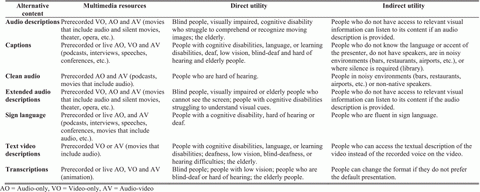
B. Multimedia Content in HTML 5
The latest HTML version 5.2 was released on December 14, 2017 [32]. HTML 5.2 has defined the tags
For example, in Fig. 1, it can be seen how HTML uses the tag
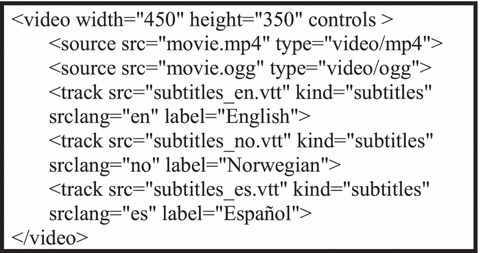
Fig. 2 shows a screenshot of the HTML code executed in the Mozilla Firefox browser using the native video player. The user has the chance to activate or deactivate the captions as well as select one of the three available languages.
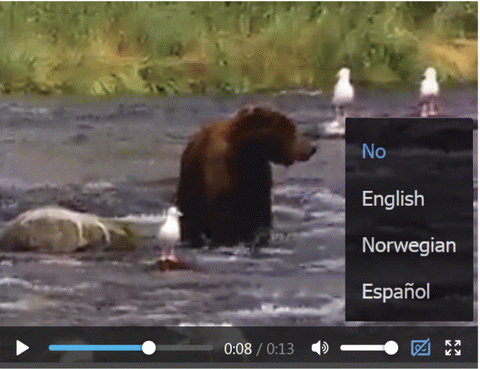
C. Multimedia Players and Browser
At present, a large number of media players are incorporated into the user agents (browsers). The main differences between the various media players lie in the accessibility features they provide to end-users [33]. For example, if we start from the fact that multimedia content is accessible, the features that differentiate multimedia players are the functions that allow end-users to enable or disable the audio descriptions, closed captions, sign language, transcriptions and visualizations of the audiovisual content independent of the format [33].
With regard to browsers, it is important to consider the compatibility and possibility of enabling the
D. Web Accessibility Standards
The goal of accessibility is that everyone, but mainly people with disabilities, can perceive, understand, navigate and interact on the web [24], [35]. People with disabilities have the possibility of using assistive technology that allows them to access web content [36]. However, assistive technology is useless if the web content is not accessible [36]. That is, during the process of designing, developing and publishing web content, the needs of people with temporary, permanent, moderate and severe disabilities must be considered. Otherwise, in some cases, the lack of accessibility on websites generates an insurmountable gap for people with severe disabilities, which deprives them of access information.
Web accessibility also provides benefits for people without disabilities. This group may include people who wear glasses, those that use devices with small screens, the elderly, those located in environments that demand silence, those in noisy environments, and/or those that use devices with slow internet connections or inadequate bandwidth [24].
For the web to be accessible, it is necessary to have interdependence among all the components of the web [37]. These components are assistive technology, authoring tools, content developers, evaluation tools, media players, and web browsers [37]. Thus, to achieve this interdependence and overcome the technological gap faced by a very important group of people around the world due to a lack of accessibility on the web, the WAI has proposed three standards [24]: ATAG, the Web Content Accessibility Guidelines (WCAG) and the User Agent Accessibility Guidelines (UAAG). Compliance with accessibility guidelines helps to improve the quality of life of people with or without disabilities [38]. On the one hand, accessibility helps to improve usability since it allows specific users to reach specific objectives effectively, efficiently and satisfactorily while using the web. Web accessibility also promotes the inclusion of all people since some of its requirements focus on UD or design for all, which is applicable to web services [39]. These guidelines consider disabilities such as cognitive and movement limitations, low vision, blindness, hearing loss, deafness, learning and speech problems, photosensitivity problems and combinations of some disabilities [24]. However, although the standards proposed by the WAI take into account a wide range of disabilities, they do not meet the needs of all people with disabilities [24]. That is, its compliance does not guarantee total universality of the web.
1) Authoring Tool Accessibility Guidelines (ATAG) 2.0 Regarding the accessibility of authoring tools, WAI published ATAG 1.0 in 2000 [40]. The objectives of ATAG 1.0 were to help developers design tools that produce accessible web content as well as provide recommendations for creating accessible author interfaces. Additionally, in 2002, WAI published a document titled Techniques for ATAG 1.0 [41]. These techniques contain only some suggestions and examples for checkpoints to be satisfied.
In 2015, WAI published ATAG 2.0 [42]. These guidelines are oriented toward creating software and services that allow authors (designers, publishers, programmers, testers, content authors, etc.) to create or modify web content through authoring tools. ATAG 2.0 includes 8 principles, 24 guidelines and 89 verifiable success criteria. ATAG 2.0 is structured into two parts or sections [42]:
Part A focuses on creating accessible authoring tools.
Part B focuses on producing accessible web content through the help of authoring tools.
In this article, we focus on the publication of multimedia content. Hence, the guidelines proposed in Part B of ATAG 2.0 have been considered. Part B of ATAG 2.0 is structured into 4 principles and 11 guidelines, as shown in Fig. 3.
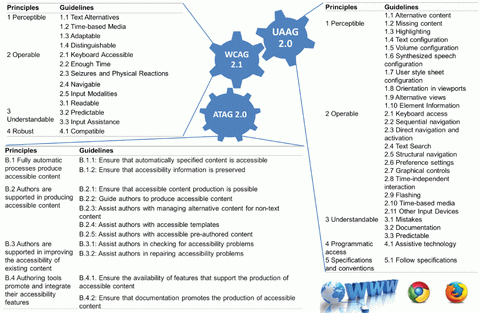
Moreover, Part B of ATAG 2.0 also includes 32 success criteria that, if applied, would benefit all end-users, particularly those with disabilities and the elderly [42]. Therefore, author tools that allow accessibility features to be incorporated into web content are more likely to be used by authors and for user agents to support them [42]. On the other hand, WAI provides non-normative information that contains the intention of the ATAG 2.0 success criteria, examples and, sometimes, references to other related resources [43].
In some cases, the authors receive very little technical information on the process of implementing the success criteria when reading ATAG 2.0. Fig. 4 shows a screenshot of success criterion B.2.4.4, which offers a small description, little information about its intent, a single example and no related resources.
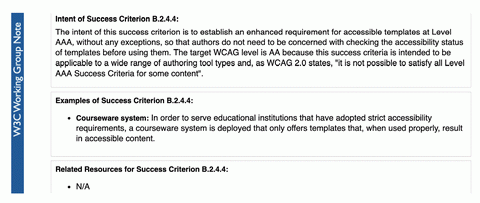
Undoubtedly, the WAI makes a great effort in providing standards and materials that help to improve web accessibility. However, to date, the WAI has not developed techniques that guide or orient authors, developers and evaluators in compliance with ATAG 2.0. It is important to note that WAI has provided techniques for other accessibility standards through which best practices and changes in technologies and tools are covered.
2) Web Content Accessibility Guidelines (WCAG) 2.1 Concerning the creation of accessible web content, WAI has proposed several versions of guidelines. WCAG 1.0 was published in 1999 [44]. Subsequently, WCAG 2.0 [45] was published in 2008, which became the ISO / IEC 40500: 2012 (W3C) standard in 2012 [30]. The latest version, WCAG 2.1, was published in June 2018 [46]. These guidelines are applicable to various types of web content that are viewed on computers, tablets and mobile devices [46]. The WCAG 2.1 took into consideration all the criteria of WCAG 2.0. Consequently, websites that meet WCAG 2.1 guidelines will also comply with the WCAG 2.0 standard [46].
WCAG 2.1 is designed to support different technologies, not only web technologies, and constitutes a stable and technical document [46]. These guidelines aim to provide the possibility of accessing web content to a wide range of people with disabilities [47]. The WCAG 2.1 is organized into 4 principles and 13 guidelines, as shown in Fig. 3. The guidelines contain 78 success criteria (17 new success criteria from version 2.0). The success criteria satisfy one of the three possible levels of conformity (A, AA and AAA) [46]. Level A corresponds to the minimum level, but compliance ensures minimum accessibility on the web. The AA level is the average level and assumes compliance with the success criteria A and AA. The advanced level is AAA, and the success criteria that meet this level would also meet A and AA levels [46].
Furthermore, the WAI provides links to resources, code, documentation on possible failures and an informative document with techniques. The techniques aim at guiding web designers, developers and evaluators to meet the success criteria of the WCAG [48]. The techniques are updated approximately three times per year and consider factors such as different types of disabilities and technological advances. The techniques for WCAG 2.1 were last updated in September 2019. The techniques are classified as sufficient, advisory and failures. The sufficient techniques allow one to meet the criteria of success; the advisory techniques go beyond the success criteria requirements and take into account other accessibility barriers that are not covered by the success criteria; failures are the aspects that do not facilitate the fulfillment of the success criteria. These failures help authors know what to avoid, and evaluators use them to verify whether multimedia content is accessible. Table 2 summarizes these techniques classified according to the technology to which they are oriented [49].
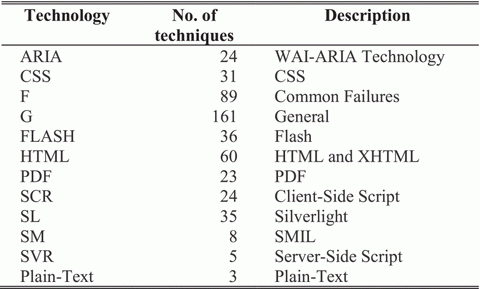
Compliance with the techniques for WCAG 2.1 does not guarantee accessibility in web content because a given technique may not be the best option for a given technology or there might be other ways to meet a success criterion [48]. To meet the success criteria in some cases, more than one technique is recommended, and the same technique can be applied to meet more than one success criterion.
3) User Agent Accessibility Guidelines (UAAG) 2.0 The WAI published UAAG 1.0 in 2002 [50]. Compliance with these guidelines promotes the accessibility of user interfaces and the ability to communicate with assistive technologies [50]. In 2002, the WAI also published a document titled Techniques for User Agent Accessibility Guidelines 1.0 [51].
In 2015, WAI published UAAG 2.0 [52]. These guidelines are organized into 5 principles and 26 guidelines, as shown in Fig. 3. UAAG 2.0 includes a total of 112 success criteria and 3 conformance levels (A, AA, and AAA) grouped under the same concept as the proposed accessibility levels in WCAG 2.0.
UAAG 2.0 is aligned with ATAG 2.0 and WCAG 2.0. The objective of UAAG 2.0 is to guide developers in the design of user agents (media players, browsers, browser extensions, assistive technologies, screen readers, braille lines, etc.) that allow the web to be accessible to people with disabilities [52]. The UAAG 2.0 application helps improve the accessibility of user interfaces and their ability to communicate with other technologies. These guidelines can also be used to assess the accessibility of user agents [52].
4) Universal Design (UD) In 1997, a group of researchers from the University of Buffalo created a paradigm known as UD [53]. This paradigm considers concepts such as barrier-free design, accessible design, and supporting technologies. UD proposes 7 guidelines [53]: equitable use, flexibility in use, simple and intuitive use, perceptible information, tolerance for error, low physical effort and size and space for approach and use, as shown in Fig. 5.
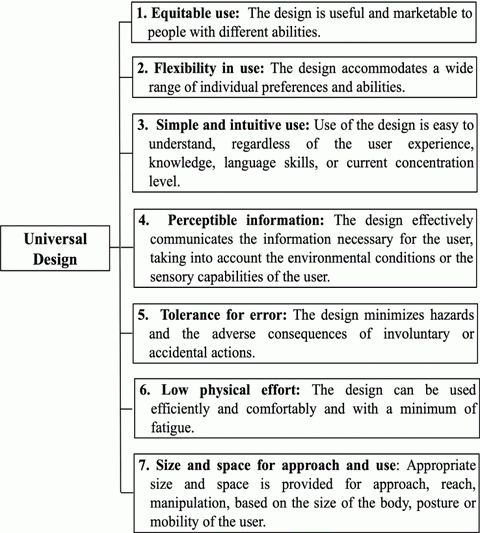
UD promotes the creation of easy-to-access environments and products for the greatest number of people without the need to make adaptations or a specialized design [53]. The application of this design promotes social inclusion and aims to reduce the barriers faced by a significant number of people due to their differences [53].
E. Publication of Accessible Multimedia Content
Based on the web accessibility standards recommended by the WAI and the principles of UD, the phases that must be met for the publication of the accessible multimedia content on the web are the following:
Inclusion of accessible multimedia resources on the web through authoring tools. The authors are the people who use the authoring tools.
Automatic generation of accessible HTML content by the authoring tool.
Access to multimedia content on the web by end-users.
In Fig. 6, each of these phases and their relationships are shown. The first phase consists of the inclusion of multimedia content on the web through the application of ATAG 2.0. The second phase consists of the automatic generation of HTML content by authoring tools, in accordance with WCAG 2.1. The third phase allows end-users to access and interact with multimedia content via user agents that are fully compliant with UAAG 2.0.
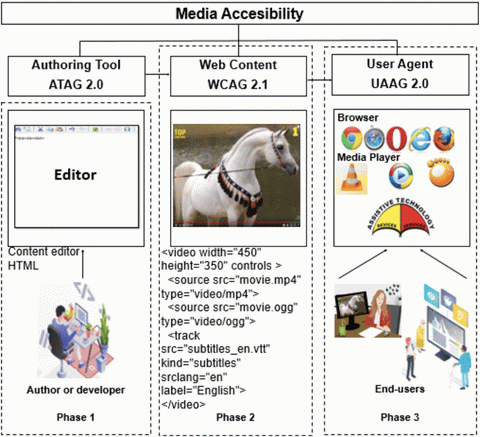
III. Related Work
In a previous investigation, we presented a preliminary approximation of a method to evaluate the accessibility of tables, images and headings created through web content editors [54]. Additionally, a total of 54 accessibility features were proposed to evaluate these elements based on the WCAG 2.0 and ATAG 2.0 standards [54]. During this work, we detected accessibility problems that authoring tools have regarding multimedia; that is why this topic was considered for future work. In another study, the proposed method was applied to evaluate the accessibility of the headings created from web content editors [55]. As a case study, the editors TinyMCE and Atto were considered on the Moodle 3.3.1 platform [55]. The results showed that these evaluated editors had a low level of compliance with ATAG 2.0 [55]. In this manuscript, an improved evaluation method is presented relative to that presented in [54]. This research work is much broader since innovative techniques are proposed in order to comply with ATAG 2.0.
Moreover, prior to this investigation, we analyzed the accessibility requirements for video players in e-learning based on UAAG 2.0 and WCAG 2.1 [27]. We identified a total of 44 success criteria corresponding to the perceptible, operable and understandable principles applicable to video players [27]. Additionally, we proposed a checklist with 125 items to quickly assess the accessibility of media players [27].
The evaluation of six video players was conducted by experts in web accessibility. These video players were randomly selected from among the best video players for Windows and Mac (Elmedia, Media Player Classic, UMPlayer, Vimeo, VLC Media Player, YouTube). The results regarding compliance with the checklist were as follows: YouTube satisfied 38% of the criteria for the perceptible principle; UMPlayer satisfied 68% of the criteria for the operable principle; and the Elmedia video player obtained the best score for the understandable principle, meeting 44% of the criteria [27]. These results showed that video players have much room for improvement to become more accessible.
Similarly, based on WCAG 2.1, we conducted further research on the accessibility of educational videos in MOOCs [28]. In that study, the 10 most popular educational platforms and 30 MOOCs in the 3 categories (technology, business, and social science) with the highest percentage of courses offered according to the report presented by Class Central were selected [28]. The results of the evaluation of videos showed that 20% included textual transcriptions in different languages, 50% included captions in two or more languages, 80% included textual transcriptions, and 90% were provided with captions in one language [28]. However, alarmingly, there was a complete absence of audio descriptions, extended audio descriptions, clean audio, textual descriptions of the video and videos with sign language [28]. Consequently, the lack of accessibility of the evaluated videos on the educational platforms is clear.
Worldwide, research has been conducted on the accessibility of multimedia. Some previous studies related to this research are described next; these studies are presented and ordered chronologically and by subjects.
Concerning the accessibility of multimedia, in 2007, a summary was presented on the aspects that should be considered regarding legislation, technologies and standards for incorporating accessible multimedia content on web pages [20]. In this investigation, WCAG 1.0 and the draft of WCAG 2.0 were considered. One of the conclusions of this study highlighted the importance of alternative content synchronized in multimedia. In contrast to our proposal, this study focused on the creation of multimedia content through the use of a player integrated into web pages, an external player, SMIL, XHTML and Flash. In our research, we are interested in proposing a set of techniques applicable to any authoring tool that allows the publishing of accessible multimedia resources in accordance with ATAG 2.0.
In 2007, an accessible internet browser for multimedia was developed; it controlled audio, metadata, and audio descriptions [17]. The conclusions of that research showed that multimedia resources were often inaccessible to blind people, given the existence of screen readers that could not detect changes in dynamic content [17]. Unlike that study, the application of the techniques proposed in our research will help end-users access multimedia content, regardless of the browser they use.
In 2008, an investigation highlighted the application of WCAG 1.0 and the draft of WCAG 2.0 in the creation of accessible multimedia content [56]. The study considered that web content must be accessible by itself and that the page that includes the multimedia content must be accessible; the interaction with the user must also be accessible. Our work differs from this study in some aspects. First, we carry out a detailed investigation of the WCAG 2.1, ATAG 2.0, and UAAG 2.0 standards and the phases that should be met in order to publish accessible multimedia content. Second, we propose a group of techniques that guide the fulfillment of the Part B success criteria related to multimedia.
In 2008, a study was conducted on the accessibility of interfaces for educational multimedia content [57]. That research presented two prototypes of accessible interfaces using XML technologies: SMIL based on WCAG 1.0 and the draft of WCAG 2.0. Their work differs from our research since we do not implement prototypes. The techniques we propose can be applied independently of the user agent interface and assistive technologies used for the reproduction of multimedia content.
In 2011, the results of an investigation showed that audiovisual resources can be considered accessible when they can be heard and seen by people with hearing or visual difficulties [6]. That study presented a Java-based prototype that allows the user to upload a video and select the segments for which captions are inserted. In their work, the authors perceived accessibility problems in a very limited way. Our research aims to propose novel techniques to reduce accessibility problems that occur during the publication of multimedia content on the web so that end-users with disabilities are not excluded from access to information.
In 2015, two investigations offered results on the accessibility of multimedia on the web [5]. These studies considered people who were born deaf or became deaf at an early age. The first study identified that one of the biggest concerns these people had was the lack of accessibility to online news. The second study confirmed that the use of captions in online videos made the internet more accessible for deaf people, even when the captions were generated by automatic tools [5]. Our research provides techniques that help to prevent and eliminate accessibility barriers created due to lack of knowledge of the authors about multimedia accessibility or because the authoring tools do not provide such functions.
In 2015, a study focused on analyzing the accessibility of videos on the most accessed websites considered the accessibility of the controls and navigation modes offered for people with visual disabilities. In that investigation, the following problems were analyzed: the number of steps necessary to access the content of a video and the barriers faced by people with disabilities. One of the conclusions of this work was that it is essential to develop accessible solutions for the content of the videos [58]. Thus, it is evident that further investigation of the field of the accessibility of multimedia on the web is necessary. In our research, we focus on ATAG 2.0 with the aim of proposing a series of techniques which allow authors with little knowledge and experience on publishing accessible multimedia resources on the web.
In 2015, another investigation based on UAAG 2.0 developed an accessible video player and presented the results obtained from a study on the needs and expectations of users as well as the requirements of the accessibility and usability of videos [59]. In the conclusions, this investigation emphasized the fact that the needs of the users must be considered from the perspective of the production and the reproduction of videos [59]. Our research is not a user agent-oriented study. This work presents a collection of techniques that can be applied for evaluating and comparing the accessibility of authoring tools regarding to multimedia.
In 2019, a study highlighted the challenge we face when we need to provide accessible multimedia content for people with disabilities [12]. The authors mentioned that the production of accessible content requires knowledge of specific standards, laws, and certain skills that must be accounted for at all stages, from production to consumption [12]. The requirements set by some people to create and publish multimedia content were not met [12]. With application of the proposed techniques in this study, authoring tools can reduce the gap faced people with disabilities during access to multimedia resources on the web.
Regarding the accessibility of multimedia players and HTML5, in 2011, an investigation was conducted on the accessibility requirements for multimedia players [33]. This investigation considered the UAAG 2.0 draft and concluded that none of the media players evaluated (YouTube, BBC iPlayer, and CCPlayer) had a sufficient degree of accessibility. Unlike that study, we do not focus on user agents; our research centers on authoring tools, with the aim of publishing accessible multimedia on the web. A similar work was carried out in 2015 [60]; this study focused on the accessibility requirements of user agents considering UAAG 2.0 and ISO 9241-171. This research designed an accessible user agent to integrate into the development process. One of the conclusions raised in this paper is that user agents must be accessible in such a way that they provide video content [60]. In our research, we consider ATAG 2.0 for the publication of accessible multimedia content.
In 2011, an investigation was carried out regarding user-videos-interactions [61]. This study concluded that users have several problems accessing videos compared to the plug-in installation requirements. It was also mentioned that there was much work to be done to include the accessibility requirements proposed by WCAG 2.0 and ATAG 2.0 [61]. The investigation considered the draft HMTL 5 and the use of the
In 2016, an investigation developed an HTML 5 accessible video player according to the UD criteria [19]. The purpose of this work was to remove the accessibility barriers faced by blind or visually impaired people [19]. The authors concluded that regardless of the accessibility of the player, if the multimedia content is not accessible, then the end-users will not understand it. On the other hand, our research does not focus on the accessibility of multimedia players. We propose techniques aimed at authoring tools that allow users with disabilities to access multimedia content from any accessible multimedia player.
In 2018, a study evaluated the accessibility of 26 video players [62]. The authors recommended that blind people should not be excluded from access to videos [62]. Our research is not focused on media players or user agents; in contrast, we focus on providing authors and authoring tools for techniques to meet the success criteria of ATAG 2.0 related to the multimedia. Additionally, we present possible failures that can cause the non-fulfillment of ATAG 2.0. Obviously, an accessible media player will be required to take advantage of the full potential of this proposal.
Concerning the previous research related to the accessibility of web content editors, in 2011, an investigation was conducted on the influence of six content management systems (Drupal, Joomla, EzPublish, Typo3, OpenCMS, and Plone) on the production of accessible web content [63]. This study was developed based on ATAG 2.0 and WCAG 1.0. However, the success criteria and the accessibility levels considered for the creation of accessible multimedia content were not detailed. One of the conclusions of the work emphasized the problems in the generation of accessible content by web content editors due to the lack of alternative text in images [63]. Our work identifies the principles, guidelines, success criteria and levels of accessibility recommended by the three standards proposed by the WAI and the UD principles applicable to the publication of accessible multimedia content. The success criteria identified can be applied to any online content editor.
IV. Method
The method we followed to meet our research objectives is illustrated in Fig. 7. This method consists of five phases that make use of part B of ATAG 2.0 [43], UAAG 2.0 [52], WCAG 2.1 [49], the draft on media accessibility user requirements [31], and the guidelines proposed in the UD [53].
PHASE 1: Study of standards and accessibility documents proposed by the WAI, UD, and other sources. This phase consists of five steps and considers a comprehensive review of:
1.1 The principles, guidelines, success criteria, and conformance levels of Part B of ATAG 2.0.
1.2 The principles, guidelines, success criteria, conformance levels, sufficient techniques, advisory techniques and common failures, code, and links to resources proposed in the WCAG 2.1.
1.3 The principles, guidelines, success criteria, and conformance levels recommended by UAAG 2.0.
1.4 The accessibility requirements that users with disabilities have with respect to audio and video on the web, presented by W3C on working draft about media accessibility user requirements.
1.5 The principles of the UD and related work.
PHASE 2: Filter the success criteria and conformance levels focused directly on the creation and publication of accessible multimedia content following the standards and previous work recommended by the WAI. This phase consists of three steps:
2.1 Filter the success criteria and conformance levels recommended by ATAG 2.0 focused directly for the publication of multimedia content accessible on the web.
2.2 Filter the success criteria, conformance levels, and techniques recommended by WCAG 2.1 focused directly on the creation of multimedia content.
2.3 Filter the success criteria and conformance levels recommended by UAAG 2.0 for the design and development of user agents. The success criteria allow multimedia content to be accessible by end-users, in accordance with UAAG 2.0.
PHASE 3: Interpret the success criteria of ATAG 2.0, which are not directly related to multimedia, but could be applied for the publication of accessible multimedia content. This phase consists of two steps:
3.1 Selection of ATAG 2.0 success criteria that could be applied in the publication of accessible multimedia content.
3.2 Interpretation of the success criteria selected in step 3.1 to publish accessible multimedia content.
PHASE 4: Results and discussion. This phase consists of two steps:
4.1 Proposal of techniques to guide authors in meeting the success criteria aimed at publishing accessible multimedia content, in accordance with Part B of ATAG 2.0.
4.2 Discussion and detection of gaps in the ATAG 2.0, WCAG 2.1 and UAAG 2.0.
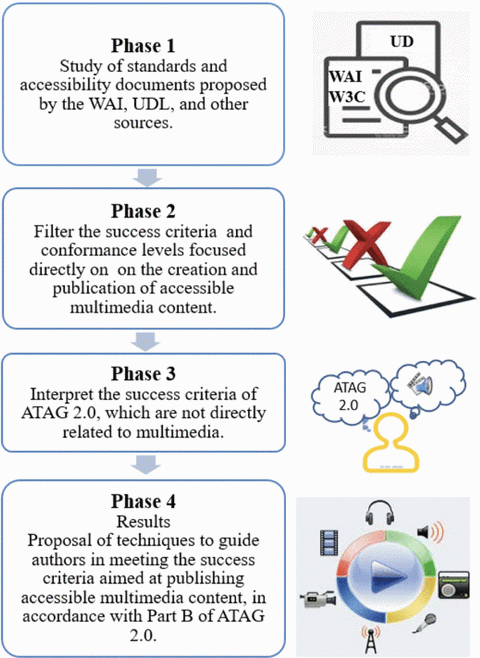
V. Results
The results of the selection of the success criteria and conformance levels recommended by ATAG 2.0 for the publication of accessible audio, video or audio-video are shown in Table 3.
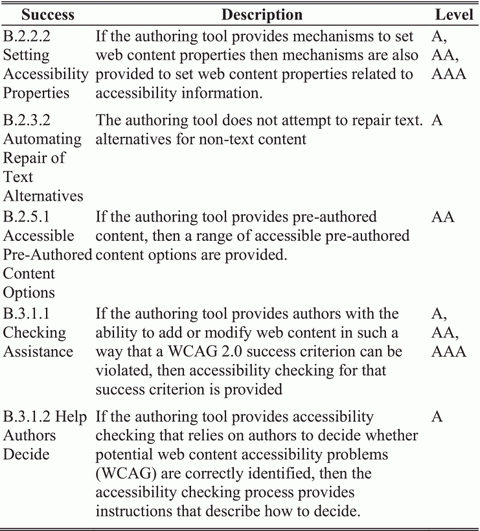
Similarly, in Table 4, the success criteria, levels of conformance, and techniques regarding the creation of accessible multimedia content, in accordance with WCAG 2.1, can be observed. The success criteria and conformance levels that accessible user agents should meet based on UAAG 2.0 can be seen in Table 5. In this work, we propose the techniques corresponding to the ATAG 2.0 success criteria that are shown in Table 3.
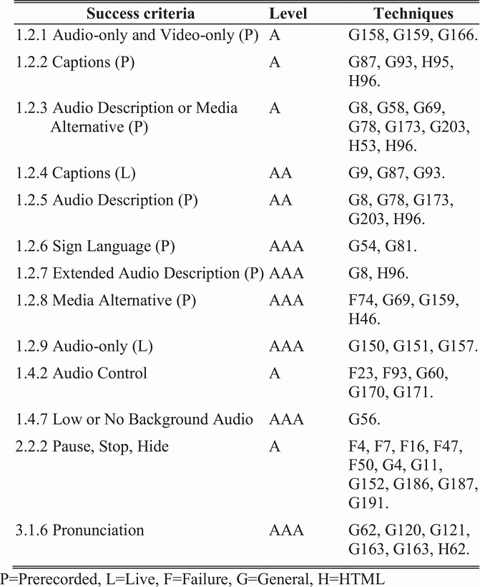
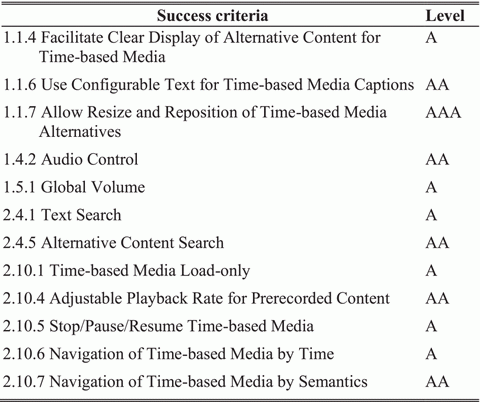
Due to the level of generalization in the presentation of the web accessibility standards proposed by the WAI, in Phase 3, 19 success criteria from the ATAG 2.0 were selected and interpreted to be applied within the process of publishing accessible multimedia content. The results of the selection of the success criteria are shown in Table 6, and their interpretation is shown in Table 7.
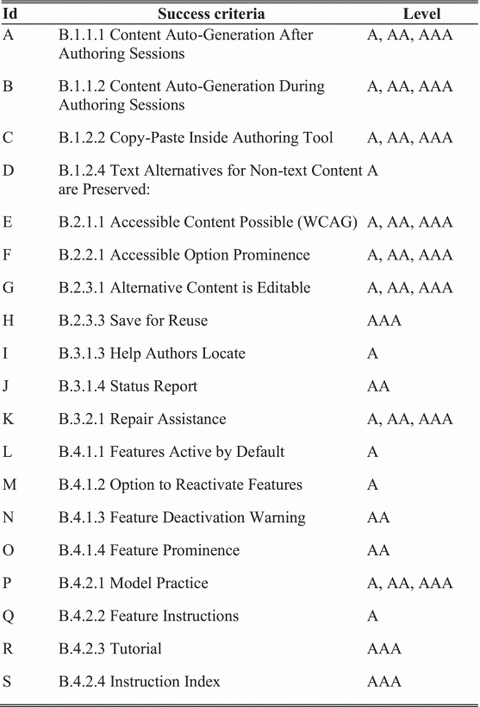
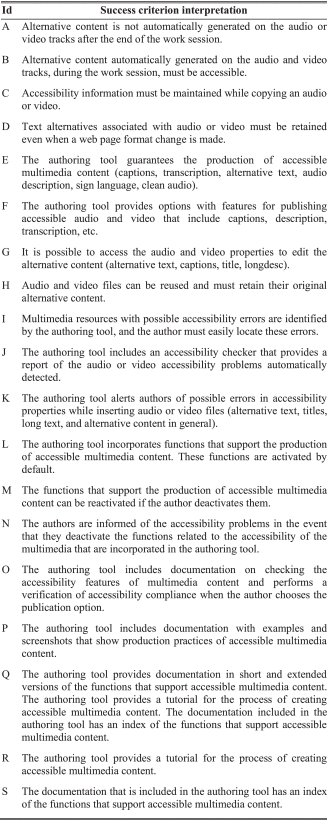
Similarly, some success criteria of WCAG 2.1 can be interpreted in order to create accessible multimedia content. For example, the success criterion 3.1.2 (Language of Parts) can be interpreted and applied to audio and video with the aim of providing captions, transcriptions, descriptions, audio descriptions, and sign language in different languages. Likewise, in cases where it is essential to listen to the audio in a language different from that selected by the author, the captions, text transcriptions, and textual video descriptions should provide the user with information about the language change. Concerning UAAG 2.0, success criteria 2.4.4 (Alert on Wrap or No Match) could be applied to the results of performing the textual search in the captions, transcripts, and textual descriptions.
In this study, in addition conducting a detailed analysis of the web accessibility standards proposed by the WAI, we interpret some success criteria of ATAG 2.0 focused on multimedia.
As a result of Phase 4, we propose 278 novel techniques that guide compliance with ATAG 2.0 for publishing accessible multimedia content. The fulfillment of these techniques provides accessibility features that enable people with or without disabilities to access multimedia content without discrimination. Additionally, we identified 80 possible failures that could cause a breach of ATAG 2.0 in terms of multimedia. These failures may occur when the authoring tools have not implemented functions that allow authors to provide accessibility features to multimedia content or when the authors are inexperienced or do not have interest in publishing accessible multimedia content. All these techniques and failures are observed in the appendix and are available online.2
The structure of the proposed techniques considers the following elements: name of the technique, guideline, ATAG 2.0 success criteria, applicability, description, example, resources, test, procedure, and expected results. These elements have been taken from the structure of the techniques for WCAG 2.1 and ATAG 1.0 recommended by the WAI [41] [48]. As an example, Table 8 shows the structure of the T1 technique (Providing the author mechanisms to set short text alternatives for prerecorded audio-only or video-only), corresponding to success criteria B.2.2.2 (Setting Accessibility Properties).
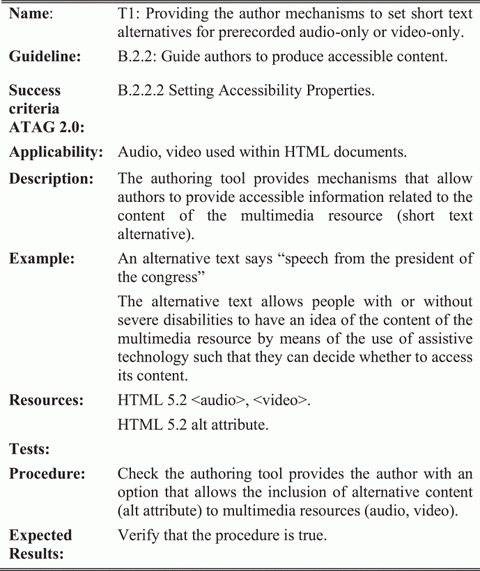
Tables 9, 10, 12, 13, 15, 17 and 19 present some of the proposed techniques and failures found in this research. The first column of these tables corresponds to the numbering of the techniques or failures. The second column contains a description of the techniques or failures with regard to the fulfillment of the objectives set out in this study.
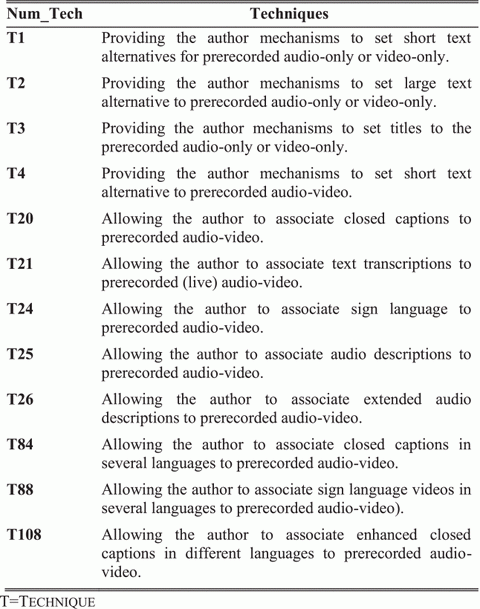
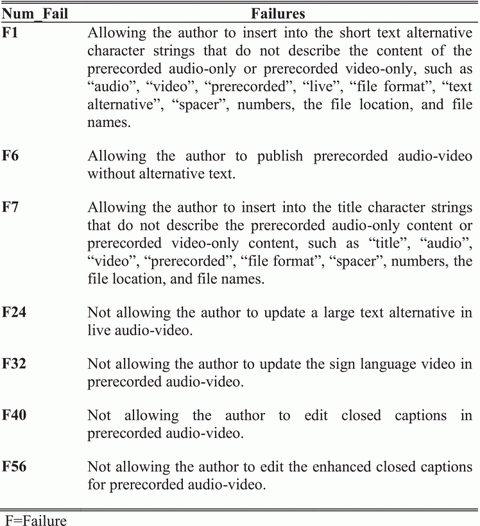
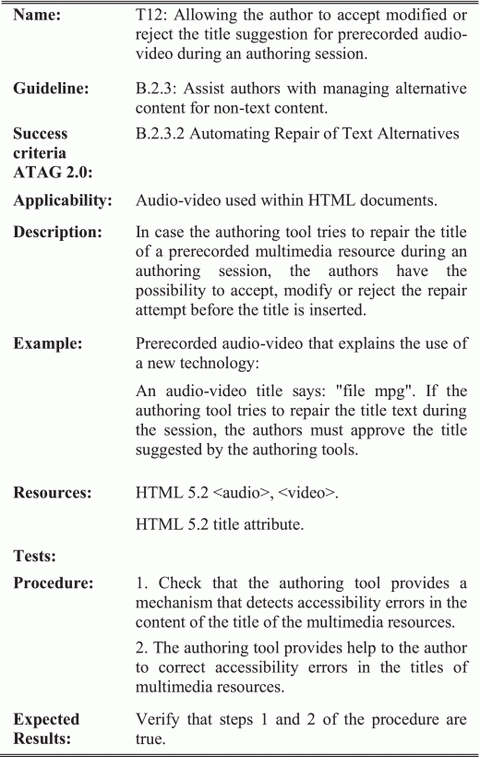
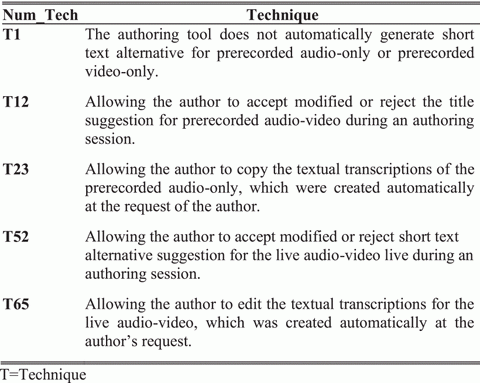
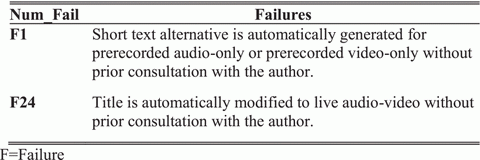
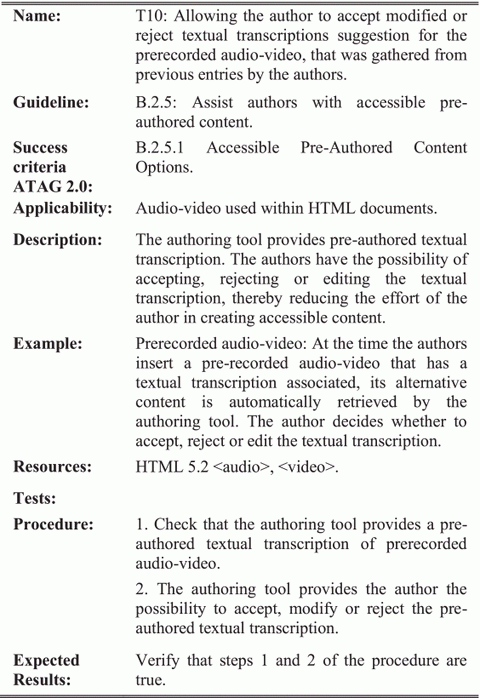
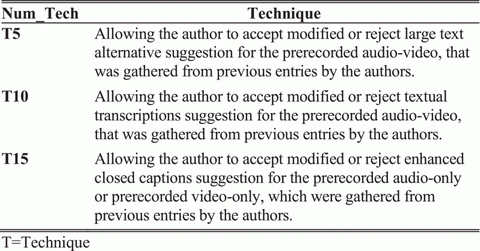
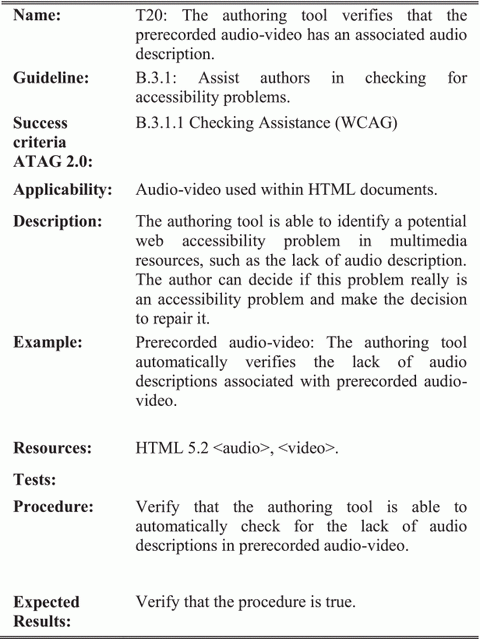
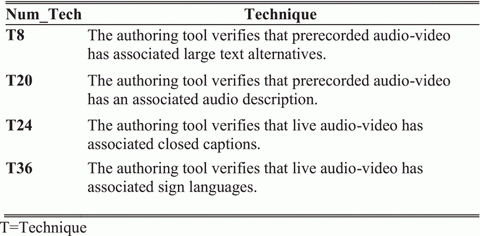
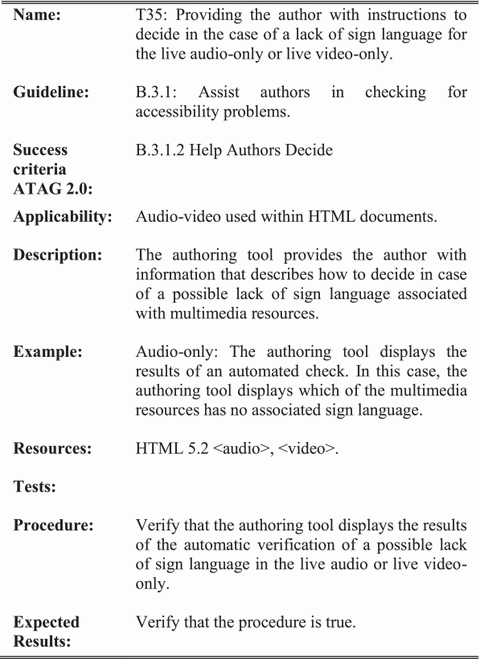
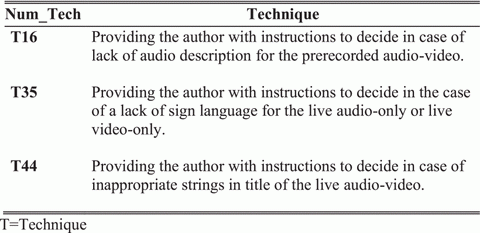
These techniques have been grouped in this way to save space and facilitate their understanding. Thus, Table 9 shows 15 of the 108 proposed techniques oriented towards the fulfillment of the criteria of success B.2.2.2. Compliance with T1–T6 techniques allows authoring tools to give authors the option to provide descriptive identification (short text alternatives, large text alternatives, titles) to the content of prerecorded audio-only, prerecorded video-only and prerecorded audio-video. Compliance with T20–T24 techniques gives authors tools to implement functions to associate textual content (closed captions, text transcriptions, text video descriptions, and extended text video descriptions) and sign language to prerecorded audio-video. Techniques T25 and T26 recommend associating audio descriptions and extended audio descriptions to prerecorded audio-video, respectively. The T84–T90 and T103–T108 techniques recommend that authoring tools provide options that allow the author to upload the textual content and sign language in different languages.
Additionally, we have identified 56 possible failures that may cause the non-fulfillment of the criterion of success B.2.2.2. Table 10 contains seven very common failures related to alternative text, which generate accessibility problems for people with disabilities who use assistive technologies. All these techniques and failures are shown in Tables 20 and Table 25 of the appendix.
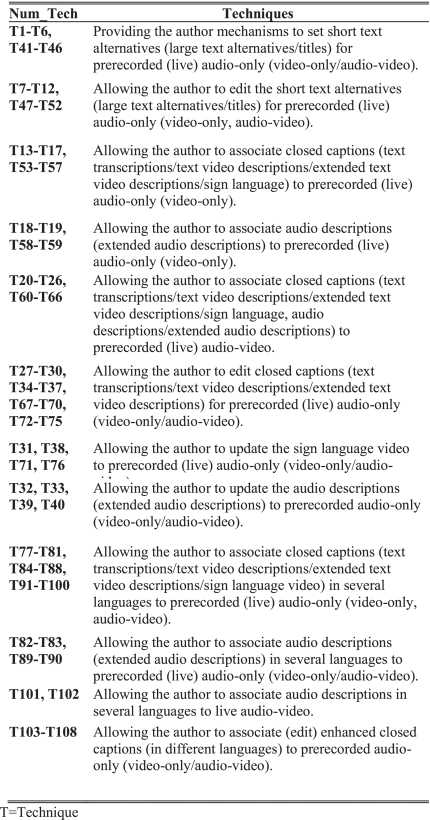
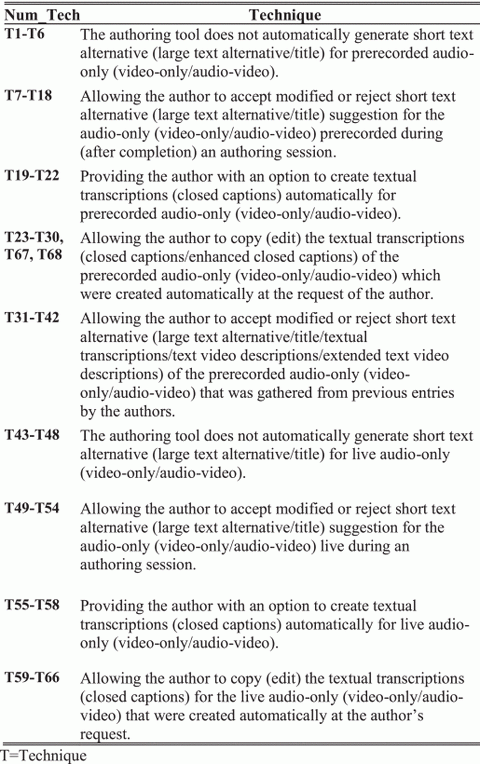
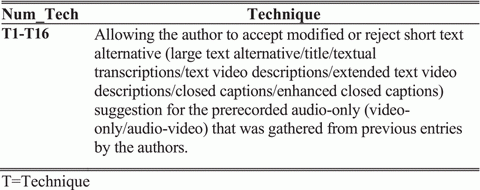
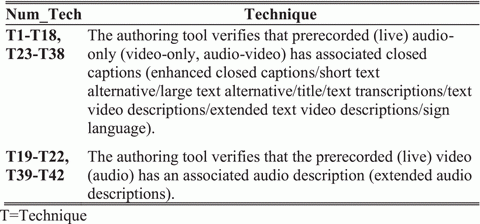
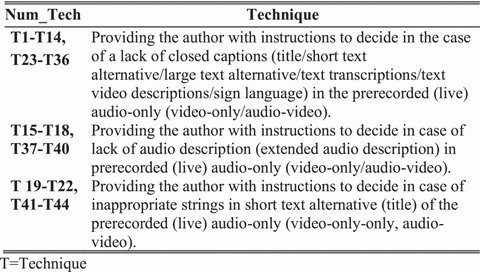
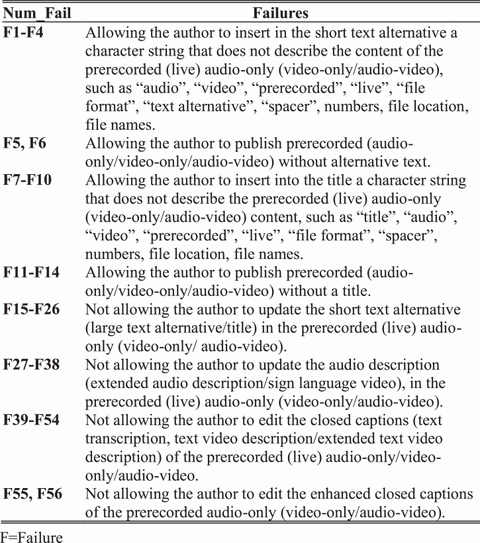
Regarding the fulfillment of the success criteria B.2.3.2 (Automating Repair of Text Alternatives), Table 11 shows the structure of the T12 technique belonging to this group. Table 12 shows 5 of the 68 proposed tec hniques that guide compliance with the success criteria B.2.3.2. The implementation of these techniques controls the automatic generation of alternative text using the authoring tools and provides the possibility of repairing the alternative text with prior authorization of the author.
Additionally, these techniques allow authoring tools to automatically generate textual content (textual transcriptions, text video description, extended text video descriptions, closed captions, and enhanced closed captions), which can be edited later by the authors. Finally, these techniques are focused on ensuring that accessibility characteristics are maintained in the event that the author copies multimedia resources. Table 21 in the appendix contains the proposal of 68 techniques that focus on compliance with B.2.3.2.
In this investigation, we have identified 24 possible failures that can cause the non-fulfillment of this criterion of success B.2.3.2. Table 13 shows two of these failures that occur when author tools automatically generate or modify textual alternatives and textual content of multimedia resources without prior consultation with the author. Table 26 in the appendix contains all the proposed failures.
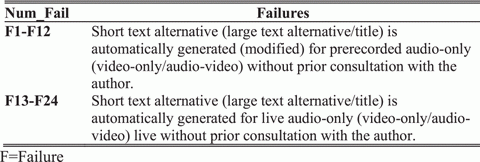
Regarding compliance with the success criteria B.2.5.1 (Accessible Pre-Authored Content Options), Table 14 shows the structure of the T10 technique belonging to this group. Table 15 shows 3 of the 16 proposed techniques that guide compliance with the success criteria B.2.5.1. These techniques help to provide authoring tools with options that allow authors to reduce the possibility of using pre-authored content that is not accessible. Table 22 in the appendix contains the proposal of 16 techniques that focus on compliance with B.2.5.1.
Regarding compliance with the success criteria B.3.1.1 (Checking Assistance), Table 16 shows the structure of the T20 technique belonging to this group.
Table 17 shows 4 of the 42 proposed techniques that guide compliance with the success criteria B.3.1.1. These techniques allow the author, through authoring tools, to receive support to improve the accessibility of existing content. Compliance with these techniques allows author tools to verify that multimedia resources are associated with closed captions, enhanced closed captions, short text alternatives, large text alternatives, titles, text transcriptions, text videos, audio descriptions, extended audio descriptions and sign language. Table 23 in the appendix contains the proposal of 42 techniques that focus on compliance with B.3.1.1.
Regarding the criterion of success B.3.1.2 (Help Authors Decide), Table 18 shows the structure of the T35 technique belonging to this group.
Table 19 shows 3 of the 44 proposed techniques that guide compliance with the success criteria B.3.1.2. These techniques guide the author in making decisions if the authoring tools identify a potential accessibility problem (for example, a lack of alternative text, audio descriptions, title, etc.). Compliance with these techniques guarantees that the authoring tools provide the authors with information on the possible causes of the accessibility problem and how to address them; for this, the authoring tools most indicate the part of the content should be examined. Table 24 in the appendix contains the proposal of 44 techniques that focus on compliance with B.3.1.2.
VI. Discussion
It is important to emphasize the WAI’s great contribution to the process of design, implementation, and publication of accessible web content through the proposed standards. A notable advantage of these standards is that they have a level of generalization that allows their independent application to the technology used. However, from the exhaustive study of accessibility standards, we have identified a few deficiencies.
A. The Web Accessibility Oriented Standards Recommended by the WAI are Abstract
This same generalization or abstraction that makes the standards accessible for various technologies becomes a weakness due to the difficulty of understanding its content, the web elements to which they must be applied, and the scope of the success criteria. This difficulty occurs precisely because of the lack of detail on the elements or aspects that should be considered in the phases of design, implementation, and publication of web content. For example:
Concerning ATAG 2.0, guideline B.3.2 (Assist authors in repairing accessibility problems) refers to the possibility of author tools detecting accessibility problems and reporting to the author but does not specify which errors the tool should detect and whether it includes errors related to multimedia.
Regarding WCAG 2.1, the success criterion 1.4.2 (Audio control) specifies neither all the options that the audio control should include nor the details regarding which multimedia elements should be provided with the audio control. This criterion does not specify whether it is necessary to incorporate independent audio controls, for example, for voice tracks, for audio, for audio descriptions, and for significant sounds.
For UAAG 2.0, guideline 2.10 (Provide control of time-based media) does not specify whether it should be applied to prerecorded or live multimedia. It does not detail which of the multimedia elements or services should be provided with a control, either.
A similar assessment regarding the subjectivity of some accessibility problems has been raised in the work published by Crespo et al. [18]. In that work, the authors argue that there may be several solutions to the same problem depending on people’s interpretation and the requirements associated with the type of disability [18]. In other words, accessibility guidelines must be adapted and implemented depending on people’s needs. For example, accessibility barriers that must be overcome by people with a certain degree of disability (auditory, visual, cognitive, motor or combinations of them) are different in cases of severe disability [64].
The detail with which the techniques for ATAG 2.0 have been proposed with respect to multimedia helps and facilitates even people who are not experts in web accessibility in the process of complying with web publishing requirements through authoring tools. One of the relevant aspects of our research is that it proposes techniques that improve the accessibility and usability of multimedia content on the web.
These techniques contribute to the solution of accessibility problems that even people with severe disabilities face. For example, the techniques that recommend that the authoring tools generate textual content in different languages from the audio and audio description allow people who are deaf-blind from birth to access multimedia content through assistive technology, such as the braille line. Likewise, the techniques recommend that authoring tools incorporate options to generate the content of audio, video, audio descriptions, extended audio descriptions, captions, and textual transcriptions in sign language. Additionally, if sign language is provided in different languages, a wider range of people with disabilities will be able to access multimedia content.
Unlike web accessibility standards, the techniques are technology-specific procedures and contain a level of detail that facilitates the implementation of web accessibility features. Therefore, it is essential to have techniques that guide compliance by setting standards that, due to technological advances, undoubtedly require continuous updating.
B. ATAG 2.0 and UAAG 2.0 Lack Techniques
The techniques proposed by the WAI are focused exclusively on compliance with WCAG 2.1, ATAG 1.0, and UAAG 1.0. The techniques for ATAG 1.0 and UAAG 1.0 are outdated. Although the techniques are not mandatory, they are very valuable guidelines for designers, developers, and authors who are interested in complying with web accessibility standards. In particular, the lack of techniques for ATAG 2.0 directly affects the process of publishing accessible multimedia content. As a result, millions of people are excluded from access to the information contained in multimedia.
For example, compliance with the 108 techniques related to the success criteria B.2.2.2 offers the possibility that the tools incorporate mechanisms that allow the author to add, edit and update information accessible to multimedia resources published on the web, such as short text alternatives, large text alternatives and titles. Moreover, authoring tools will allow the association of a timed text object, an audio object and a secondary video (captions, text transcription, text video description, audio description, sign language interpretation, etc.). The application of these techniques allows deaf-blind people, cognitively disabled and severely disabled people to access audio content, text content and sign language related to multimedia.
With respect to failures that cause the breach of the success criterion B.2.2.2, they must be corrected in the authoring tools since they cause barriers that hinder and, in some cases, do not allow important groups of people to access information on the audios and videos published on the web. For example, the lack of alternative text associated with an audio or video causes people who use assistive technology to have no idea of the information that multimedia resources contain, forcing these people to access all multimedia resources in order to know their content.
This problem causes a loss of time and may even cause frustration in end-users in addition to the violation of all people’s right to access information. Fig. 8 and Fig. 9 show screenshots of a blog-publishing service (Blogger) that allows a video to be published on the web but does not offer the author the possibility of adding video accessibility features (alternative text, captions, text transcription, audio description, sign language to the video, etc.). That is, Blogger is a tool widely used on the web that does not allow the user to publish accessible videos.

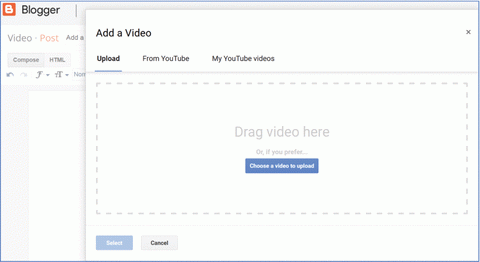
Fig. 10 and Fig. 11 show that the Moodle 3.8+ Atto provide some options that allow accessible multimedia content (subtitles, captions, and descriptions) to be published. However, the Moodle editor lacks options that allow audio descriptions, sign language interpretations, transcriptions, and text video descriptions to be added, demonstrating the importance of the techniques we propose in this manuscript as a result of the research done.
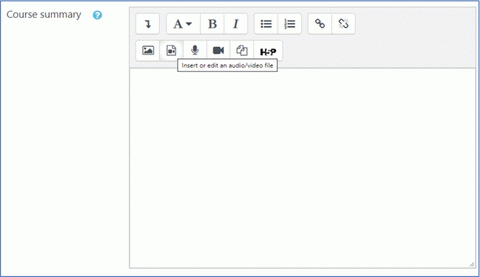
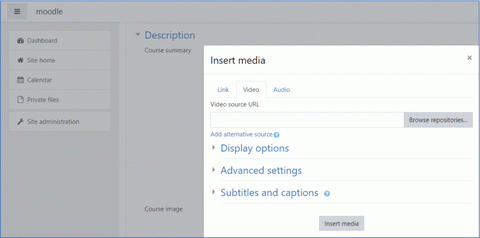
With respect to the compliance with techniques proposed for the success criteria B.2.3.2, the objective is that the authoring tools assist the authors in administrating alternative content for multimedia resources. These techniques prevent the automatic generation of useless textual alternatives for end-users and ensure that the author authorizes or rejects their publication. These techniques also provide the possibility of making corrections in the automatically generated textual content (captions, textual transcription and description). Textual content for multimedia content offers the possibility for deaf and hard-of-hearing people to access the information contained in these resources. These techniques directly benefit people with disabilities because they allow them to access the information contained in the multimedia through assistive technology such as screen readers, braille lines, applications that transform text into sign language, etc. These techniques also benefit people with cognitive impairments and with limited reading skills. With respect to the failures associated with the success criterion B.2.3.2, we have identified those that produce alternative text or textual content that does not correctly describe the content of the multimedia resource. These failures cause accessibility barriers for people with and without disabilities. The implementation of these techniques also means that options must be provided to enable or disable captions, enhanced captions, options to play or pause the multimedia resource until the end-user finishes reading or decides to resume the playback of that resource.
The techniques that guide the fulfillment of the success criterion B.2.5.1 provide the possibility that authoring tools have built-in options that allow retrieving and editing accessible pre-authored content. For instance, when inserting a video, the closed captions, text alternatives, textual transcriptions, and textual descriptions should be automatically retrieved if they were previously created.
The techniques aimed at complying with the success criteria B.3.1.1 seek to ensure that the authoring tools support the authors in addressing problems in the process of editing content. For example, when they edit the pre-authored content such as closed captions, text alternatives, textual transcriptions, textual descriptions. Additionally, these techniques allow authoring tools to verify that multimedia resources have associated audio descriptions and sign language interpretations.
The techniques that lead the fulfillment of the criterion of success B.3.1.2 may allow the authoring tools to offer information and instructions to the authors in such a way that they can make appropriate decisions when identifying accessibility problems in multimedia content. The application of these techniques provides a great deal of help, especially to inexperienced authors, regarding web accessibility.
VII. Conclusion
Multimedia is one of the most frequently used resources on the web; thus, it is essential to provide accessibility features that enable people with or without disabilities to access multimedia content.
The accessibility standards proposed by the WAI (ATAG 2.0, WCAG 2.1, and UAAG 2.0) have been adopted by many countries worldwide. However, the lack of observation and application of these standards by authors, designers, and web developers has created a technological gap that significantly affects people with disabilities and older adults. One of the possible causes of the low level of compliance with the accessibility standards could be the generalization in the writing of these standards, which cause confusion or difficulty to the responsible persons in the design and implementation process of web accessibility.
The lack of accessibility violates the human rights of millions of people around the world. On the one hand, it causes exclusion in the access to information, thereby ignoring the idea that access to information is a right, not a privilege. On the other hand, the right to equal treatment, non-discrimination, and the right to have an equal opportunity for academic success are undermined if inaccessible multimedia is included in e-learning platforms.
The publication of multimedia resources on the web is achieved mainly through authoring tools. The lack of techniques to guide the fulfillment of the ATAG 2.0 success criteria is one of the causes of the inaccessibility of multimedia on the web. Significant results have been produced in this investigation. Therefore, our paper contributes to the body of knowledge on multimedia accessibility because, unlike any preceding work, it proposes 278 novel techniques that guide the fulfillment of the success criteria B.2.2.2, B.2.3.2, B.2.5.1, B.3.1.1, and B.3.1.2 of ATAG 2.0. These techniques can be considered to guide authors in the publication of multimedia resources accessible on the web through authoring tools.
The proposed techniques can also be used to evaluate existing authoring tools on the features or functions that they provide for the publication of accessible multimedia resources on the web. The techniques can also be used to guide the creation of new accessible authoring tools. Moreover, this study proposes 80 possible failures that would negatively affect compliance with the success criteria recommended by ATAG 2.0. In future work and as a second phase of this research, we will propose a method for evaluating and comparing authoring tools by applying the techniques presented in this manuscript. The application of this method will validate and demonstrate the suitability of the investigation that we have carried out. The evaluation will be conducted by considering the most accessed multimedia content editors worldwide, expert and novice authors in web accessibility and the different types of disabilities of end-users.
We have not considered metadata since the technical information on multimedia files is not a basis for this study. Perhaps in the future, we could investigate this topic further as well. For our future work, we plan to expand the number of techniques that guide the fulfillment of the 19 success criteria of ATAG 2.0 that were interpreted in this research. The interpretation of these success criteria was attempted due to the level of abstraction of their writing, which causes difficulties in non-expert people in accessibility who, nevertheless, create and publish multimedia content on the web. Other future work could be directed towards proposing techniques for meeting the success criteria of UAAG 2.0 because, like ATAG 2.0, WAI has not yet published the corresponding techniques. With the results achieved in this research, we intend to contribute to the fulfillment of the universality of the web and to the consolidation of inclusive education.
References
- [1] World Health Organization (WHO). (2011). World Report on Disability. Accessed: Feb. 2, 2019. [Online]. Available: http://www.who.int/disabilities/world_report/2011/report.pdf
- [2] M. Brault. (2012). Americans with disabilities: 2010. United States Census Bureau. Accessed: Dec. 10, 2019. [Online]. Available: https://www2. census.gov/library/publications/2012/demo/p70-131.pdf
- [3] Government of Canada. (2017). Making an Accessible Canada for Persons With Disabilities. Accessed: Jan. 10, 2020. [Online]. Available: https://www.canada.ca/en/employment-social-development/programs/ accessible-people-disabilities.html
- [4] Observatorio Estatal de la Discapacidad. Informe Olivenza 2018, Sobre la Situación General de la Discapacidad en España. Accessed: Jan. 25, 2020. [Online]. Available: https://www.observatoriodeladiscapacidad.info/wpcontent/ uploads/2019/04/OED-INFORME-OLIVENZA-2018.pdf
- [5] B. N. Shiver and R. J. Wolfe, ``Evaluating alternatives for better deaf accessibility to selected Web-based multimedia,'' in Proc. 17th Int. ACM SIGACCESS Conf. Comput. Accessibility (ASSETS), New York, NY, USA, 2015, pp. 231-238.
- [6] F. Paniagua-Martin, A. Garcia-Crespo, R. Colomo-Palacios, and B. Ruiz- Mezcua, ``Semantic annotation architecture for accessible multimedia resources,'' IEEE MultimediaMag., vol. 18, no. 2, pp. 16-25, Feb. 2011.
- [7] WordStream. 37 Staggering Video Marketing Statistics for 2018. Accessed: Dec. 27, 2019. [Online]. Available: https://www.wordstream. com/blog/ws/2017/03/08/video-marketing-statistics
- [8] Cisco, ``Cisco visual networking index: Forecast and trends 2017-2022,'' White Paper. Accessed: Feb. 2, 2020. [Online]. Available: https://www. cisco.com/c/en/us/solutions/collateral/service-provider/visualnetworking- index-vni/white-paper-c11-741490.html
- [9] K. Smith. 126 Amazing Social Media Statistics and Facts. Accessed: Feb. 18, 2019. [Online]. Available: https://www.brandwatch. com/blog/amazing-social-media-statistics-and-facts/
- [10] United Nations. (2006). Convention on the Rights of Persons With Dis- abilities and Optional Protocol. Accessed: Jan. 28, 2020. [Online]. Available: https://www.un.org/development/desa/disabilities/conventionon- the-rights-of-persons-with-disabilities.html
- [11] V. Cantoni, M. Cellario, and M. Porta, ``Perspectives and challenges in elearning: Towards natural interaction paradigms,'' J. Vis. Lang. Comput., vol. 15, no. 5, pp. 333-345, Oct. 2004.
- [12] C. Duarte and M. J. Fonseca, ``Multimedia accessibility,'' in Web Acces- sibility (Human-Computer Interaction Series), Y. Yesilada and S. Harper, Eds., 2nd ed. London, U.K.: Springer, 2019, ch. 25, pp. 461-475.
- [13] E. Verdú, P. Garcsía-Bustelo, Á. M. Sánchez, and R. Gonzalez-Crespo, ``A system to generate SignWriting for video tracks enhancing accessibility of deaf people,'' Int. J. Interact. Multimedia Artif. Intell., vol. 4, no. 6, pp. 109-115, 2017.
- [14] H. C. Minin, J. J. Alemán, C. Sacramento, and D. G. Trevisan, ``A WYSIWYG editor to support accessible Web content production,'' in Proc. Int. Conf. Universal Access Hum.-Comput. Interact. Access Today's Technol. (UAHCI), Los Angeles, CA, USA, 2015, pp. 221-230.
- [15] A. Iglesias, L. Moreno, P. Martínez, and R. Calvo, ``Evaluating the accessibility of three open-source learning content management systems: A comparative study,'' Comput. Appl. Eng. Edu., vol. 22, no. 2, pp. 320-328, Jun. 2014.
- [16] A. Alamri, G. Muhammad, A. Al Elaiwi, K. Al-Mutib, and M. Hossain, ``Media content adaptation framework for technology enhanced mobile elearning,'' J. Universal Comput. Sci., vol. 20, no. 15, pp. 2016-2023, 2014.
- [17] H. Miyashita, D. Sato, H. Takagi, and C. Asakawa, ``Making multimedia content accessible for screen reader users,'' in Proc. Int. Cross-Disciplinary Conf. Web Accessibility (W4A), Banff, AB, Canada, 2007, pp. 126-127.
- [18] R. G. Crespo, J. P. Espada, and D. Burgos, ``Social4all: Definition of specific adaptations in Web applications to improve accessibility,'' Comput. Standards Inter., vol. 48, pp. 1-9, Nov. 2016.
- [19] C. Earl and E. Neal, ``HTML 5 accessible video player: How and why,'' presented at the Web All Conf. (W4A), Montreal, QC, Canada, 2016.
- [20] L. Moreno, A. Iglesias, and P. Martínez, ``Accessibility of multimedia resources in Web,'' in Proc. Int. Conf. Web Inf. Syst. Tech. (WEBIST), Barcelona, Spain, 2007, pp. 470-473.
- [21] S. Patel. 85 Percent of Facebook Video is Watched Without Sound. Accessed: Jan. 18, 2020. [Online]. Available: https://digiday.com/ MEDIA/SILENT-WORLD-FACEBOOK-VIDEO/
- [22] M. Armstrong, ``Automatic recovery and verification of subtitles for large collections of video clips,'' SMPTE Motion Imag. J., vol. 126, no. 8, pp. 1-7, Oct. 2017.
- [23] T. Thompson, ``Media player accessibility: Summary of insights from interview & focus group,'' J. Technol. Persons Disabilities, vol. 6, no. 30, pp. 325-335, 2018.
- [24] Web Accessibility Initiative (WAI). Introduction to Web Accessibil- ity. Accessed: Feb. 10, 2020. [Online]. Available: https://www.w3.org/ WAI/fundamentals/accessibility-intro/
- [25] World Wide Web Consortium (W3C). About W3C. Accessed: Feb. 16, 2020. [Online]. Available: https://www.w3.org/Consortium/
- [26] World Wide Web Consortium (W3C). Accessibility. Accessed: Feb. 16, 2020. [Online]. Available: https://www.w3.org/standards/ webdesign/accessibility
- [27] T. Acosta, J. Zambrano, and S. Luján-Mora, ``Analysis of accessibility requirements for video players on e-learning,'' in Proc. Int. Conf. Educ. Learn. Technol. (EDULEARN), Palma, Spain, 2019, pp. 8310-8319.
- [28] T. Acosta, J. Zambrano, and S. Luján-Mora, ``Analysis of the accessibility of educational videos in massive open online courses,'' in Proc. Int. Conf. Educ. Learn. Technol. (EDULEAN), Palma, Spain, 2019, pp. 8321-8331.
- [29] W3schools. HTML Multimedia. Accessed: Jan. 11, 2020. [Online]. Available: https://www.w3schools.com/html/html_media.asp
- [30] International Organization for Standardization, document ISO/IEC 40500:2012 (W3C). Accessed: Dec. 28, 2019. [Online]. Available: https://www.iso.org/standard/58625.html
- [31] World Wide Web Consortium (W3C). Media Accessibility User Requirements. Accessed: Feb. 16, 2020. [Online]. Available: http://w3c.github.io/apa/media-accessibility-reqs/
- [32] World Wide Web Consortium (W3C). HTML 5.2. Accessed: Apr. 2019. [Online]. Available: https://www.w3.org/TR/html52/
- [33] L. Moreno, M. Gonzalez, P. Martínez, and A. Iglesias, ``A study of accessibility requirements for media players on the Web,'' in Proc. Int. Conf. Universal Access Hum.-Comput. Interact. (UAHCI), 2011, pp. 249-257.
- [34] L. Xu, B. Xu, C. Nie, H. Chen, and H. Yang, ``A browser compatibility testing method based on combinatorial testing,'' in Proc. Web Eng. Int. Conf. (ICWE), Oviedo, Spain, 2003, pp. 310-313.
- [35] S. Luján-Mora, ``Web accessibility among the countries of the European Union:Acomparative study,'' Actual Problems Comput. Sci., vol. 1, no. 13, pp. 18-27, 2013.
- [36] R. González-Crespo, and Ó. Sanjuán-Martínez, ``LaWeb 3.0 al servicio de las personas discapacitadas auditivas mediante las pautas de accesibilidad 2.0,'' Soc. y Utopía. Revista de Ciencias Sociales, no. 36, pp. 153-172, 2010.
- [37] Web Accessibility Initiative (WAI). Essential Components of Web Accessibility. Accessed: Feb. 16, 2020. [Online]. Available: https://www.w3.org/WAI/fundamentals/components/
- [38] Web Accessibility Initiative (WAI). About W3C WAI. Accessed: Jan. 4, 2020. [Online]. Available: https://www.w3.org/WAI/about/
- [39] Web Accessibility Initiative (WAI). Accessibility, Usability, and Inclusion. Accessed: Jan. 9, 2020. [Online]. Available: https://www.w3.org/WAI/fundamentals/accessibility-usability-inclusion/
- [40] World Wide Web Consortium (W3C). Authoring Tool Accessibility Guidelines (ATAG) 1.0. Accessed: Jan. 16, 2020. [Online]. Available: https://www.w3.org/TR/ATAG10/
- [41] World Wide Web Consortium (W3C). Techniques for Authoring Tool Accessibility Guidelines 1.0. Accessed: Feb. 5, 2020. [Online]. Available: https://www.w3.org/TR/ATAG10-TECHS/
- [42] World Wide Web Consortium (W3C). Authoring Tool Accessibility Guidelines (ATAG) 2.0. Accessed: Feb. 5, 2019. [Online]. Available: https://www.w3.org/TR/ATAG20/
- [43] World Wide Web Consortium (W3C). Implementing ATAG 2.0. Accessed: Feb. 16, 2020. [Online]. Available: https://www.w3.org/TR/ATAG20- TECHS/
- [44] World Wide Web Consortium (W3C). Web Content Accessibility Guide- lines (WCAG) 1.0. Accessed: Jan. 16, 2020. [Online]. Available: https://www.w3.org/TR/WAI-WEBCONTENT/
- [45] World Wide Web Consortium (W3C). Web Content Accessibility Guide- lines (WCAG) 2.0. Accessed: Jan. 20, 2019. [Online]. Available: https://www.w3.org/TR/WCAG20/
- [46] World Wide Web Consortium (W3C). Web Content Accessibility Guide- lines (WCAG) 2.1. Accessed: Jan. 28, 2020. [Online]. Available: https://www.w3.org/TR/WCAG21/
- [47] Web Accessibility Initiative (WAI). Web Content Accessibility Guide- lines (WCAG) Overview. Accessed: Jan. 27, 2020. [Online]. Available: https://www.w3.org/WAI/standards-guidelines/wcag/
- [48] Web Accessibility Initiative (WAI). Understanding Techniques for WCAG Success Criteria. Accessed: Dec. 12, 2019. [Online]. Available: https://www.w3.org/TR/UNDERSTANDING-WCAG20/understandingtechniques. html
- [49] Web Accessibility Initiative (WAI). Techniques for WCAG 2.1. Accessed: Dec. 4, 2019. [Online]. Available: https://www.w3.org/WAI/ WCAG21/Techniques/
- [50] World Wide Web Consortium (W3C). User Agent Accessibility Guide- lines (UAAG) 1.0. Accessed: Jan. 20, 2020. [Online]. Available: https://www.w3.org/TR/UAAG10/
- [51] World Wide Web Consortium (W3C). Techniques for User Agent Acces- sibility Guidelines 1.0. Accessed: Jan. 16, 2020. [Online]. Available: https://www.w3.org/TR/UAAG10-TECHS/
- [52] World Wide Web Consortium (W3C). User Agent Accessibility Guide- lines (UAAG) 2.0. Accessed: Feb. 10, 2020. [Online]. Available: https://www.w3.org/TR/UAAG20/
- [53] North Carolina State - The Center for Universal Design. (1997). The Prin- ciples of Universal Design. Accessed: Jan. 26, 2019. [Online]. Available: https://projects.ncsu.edu/ncsu/design/cud/about_ud/udprinciplestext.htm
- [54] T. Acosta, P. Acosta-Vargas, L. Salvador-Ullauri, and S. Luján-Mora, ``Method for accessibility assessment of online content editors,'' in Proc. Int. Conf. Inform. Technol. Syst. (ICITS), Ecuador, South America, 2018, pp. 538-551.
- [55] T. Acosta, S. Luján-Mora, and P. Acosta-Vargas, ``Method for accessibility assessment of heading in online editors,'' in Proc. 9th Int. Conf. Edu. Technol. Comput. (ICETC), Spain, 2017, pp. 243-247.
- [56] L. Moreno, P. Martínez, and B. Ruiz-Mezcua, ``Disability standards for multimedia on theWeb,'' IEEE MultimediaMag., vol. 15, no. 4, pp. 52-54, Oct. 2008.
- [57] L. Moreno, A. Iglesias, P. Martínez, and B. B. Ruiz, ``Accessible interface for educational multimedia contents,'' in Proc. Workshop Adv. Learn. Technol. Disabled Non-Disabled People (WALTD), Cantabria, Spain, 2008, pp. 56-60.
- [58] J. M. Rosas-Villena, B. Ramos, R. Goularte, and R. Fortes, ``Video accessibility on the most accessed websites - A case study regarding visual disabilities,'' in Proc. Int. Conf. Universal Access Hum.-Comput. Inter- act. Access Today's Technol. (UAHCI), Los Angeles, CA, USA, 2015, pp. 231-241.
- [59] J. M. Rosas-Villena, R. Goularte, and R. P. de Mattos Fortes, ``A user test with accessible video player looking for user experience,'' in Proc. Int. Conf. Universal Access Hum.-Comput. Interact. (UAHCI), Crete, Greece, 2014, pp. 623-633.
- [60] M. González, L. Moreno, and P. Martínez, ``Approach design of an accessible media player,'' Universal Access Inf. Soc., vol. 14, no. 1, pp. 45-55, Mar. 2015.
- [61] L. Moreno, P. Martínez, A. Iglesias, and M. Gonzalez, ``HTML5 support for an accessible user-video-interaction on theWeb,'' in Proc. Conf. Hum.- Comput. Interact. (INTERACT), Lisbon, Portugal, 2011, pp. 535-539.
- [62] G. Wild, ``The inaccessibility of video players,'' in Proc. Int. Conf. Computer Helping People Special Needs (ICCHP), Linz, Austria, 2018, pp. 47-51.
- [63] J. M. López, A. Pascual, L. Masip, T. Granollers, and X. Cardet, ``Influence of Web content management systems in Web content accessibility,'' in Proc. Int. Conf. Hum.-Comput. Interact. (INTERACT), Lisboa, Portugal, 2011, pp. 548-551.
- [64] R. González-Crespo, L. J. Aguilar, and O. Ó. Sanjuán-Martínez, ``Improving access to IT services for people with disability through software aids,'' J. Ambient Intell. Smart Environ., vol. 4, no. 6, pp. 563-564, 2012.